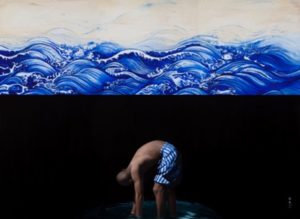
Na Wei
- HOME
- |
- Na Wei
Na Wei was born in 1982 and graduated from the Luxun Academy of Fine Arts.
Across his oeuvre, Na Wei has, with each new series, consistently challenged himself to make something fresh that speaks to varied aspects of society. In whatever style he finds himself working, from figuration to hyperrealism, from abstraction to surrealism, Na Wei’s narratives unite personal ideology, the natural, the spiritual, and the quotidian worlds with flair. Although his images speak to concrete realities, the imprisoned self, and the intricate, un- certain surface of things, it is neither the self nor the surface he wants us to think about: it is the hidden, the engine of all things, from oppression to rage to love, from compassion to the eroticism of violence and voyeurism.
Many of Na Wei’s recent works, are connected to earlier landscape paintings. A part of the success of Na Wei’s landscapes is the use of colors, muted blues and yellows to bright, bold red of his waves, dark greys for his ears, and rusted brown and black for his bamboo. His decision on which colors to use and how to use them has an historical component to it. ‘The way and techniques I apply for the colors in my recent works are similar to the traditional paintings, a bit like the ancient Chinese scholar’s painters,’ says Na Wei. ‘There are also some subjective colors to suggest certain ideas. My colors are industrially made, some of them are bright and vivid but they appear to be cold.’
His use of silk-screening to make the stripes that cut across the surface of many of his best works not only give the paintings an intriguing grid patterns through which to observe Na Wei’s vision of nature but also lend a different perspective to landscape and the passage of time.
While the use of silk-screening adds a strong linear element to the works that make up his Bamboo and Rock (Jiang Shan) Landscape series, perhaps the most powerful, and most memorable, line in his recent art is the bamboo, which ranges from delicate to thick and dramatic, an essential natural force. The calligraphic influence is clear: this element plays with notions of time and space and the history of an ancient art form that continues to influence artists. Abstraction, regardless of cultural origin, Western or Chinese, is one of the most engaging characteristics of his art. Na Wei’s sense of abstraction comes from the Chinese concept of xieyi, or freehand style and calligraphy.






